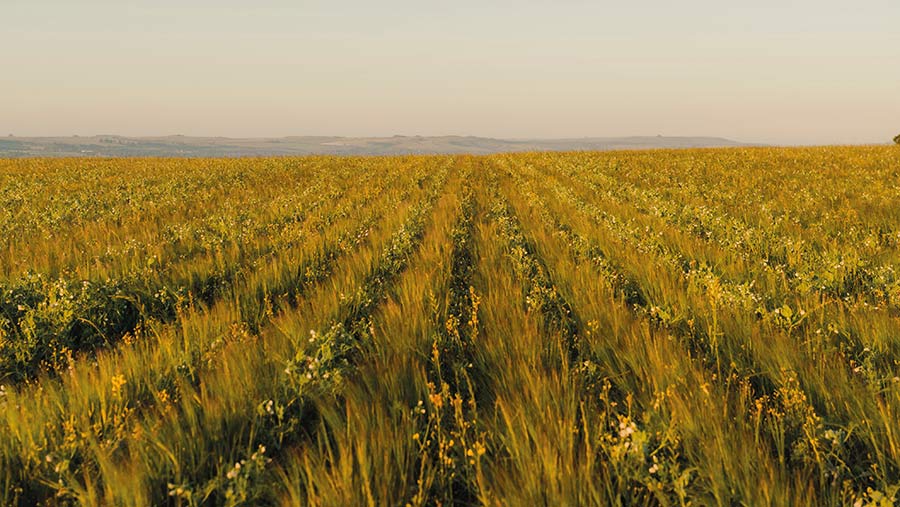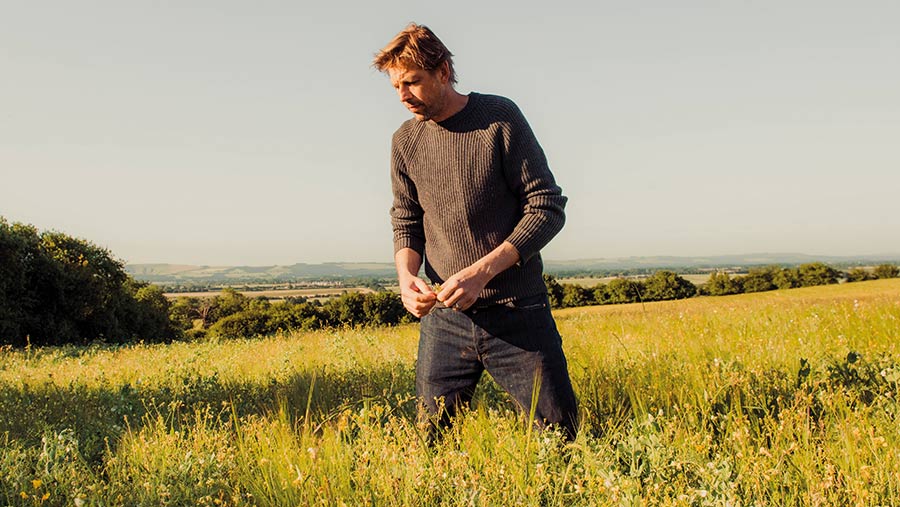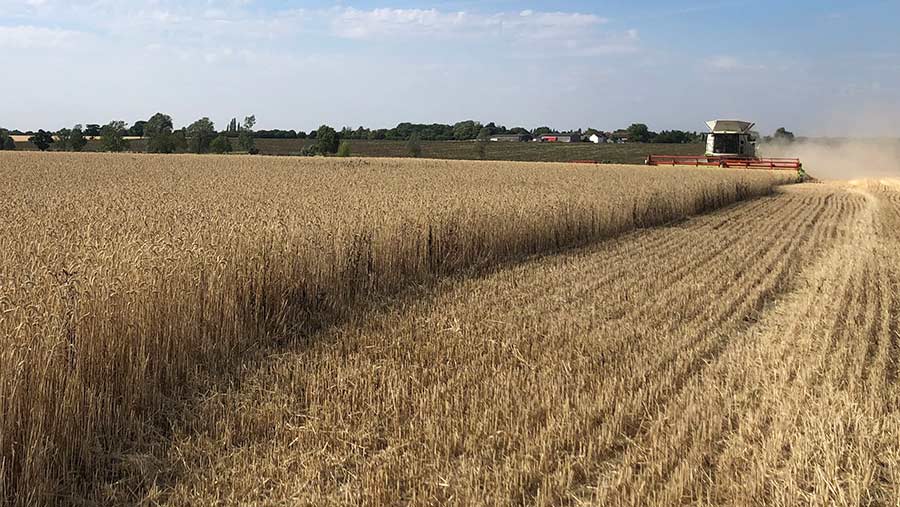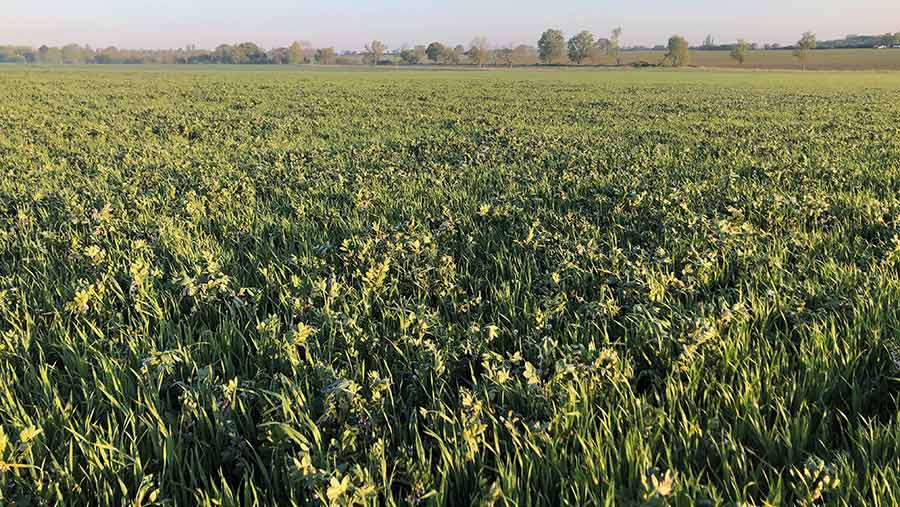Wildfarmed: How regen farmers can benefit from premium
 © Wildfarmed
© Wildfarmed A new route to market for cereals grown with regenerative farming practices is on offer from Wildfarmed, giving consumers the chance to support the restoration of soil and biodiversity.
In a challenge to the status quo and putting nature at the heart of food production, Wildfarmed will reward farmers with a premium for crops grown on dedicated blocks of land with greater plant diversity, such as in bicrops, polycrops or with companion cropping.
See also: Regenerative agriculture: What to avoid and how to start
The company has developed a set of robust standards that will be audited independently and are being observed by its community of arable farmers.
In return, the collaborative supply chain business gives growers the choice on whether to fix the price or take the premium on a floating basis at harvest.
This year’s fixed wheat price is £310/t – last year Wildfarmed paid a premium of more than 25%.
What are the Wildfarmed standards?
- Cash crops sown with pulses, other companions or in an annual/perennial mix
- Minimise bare soil, using cover crops ahead of spring crops
- Use a maximum of 80kg of N/ha – with nutrition based on need derived from plant sap analysis and leaf testing
- No insecticides, fungicides or herbicides
- Integrate livestock into the system at least once in a three-year rotation
Climate and biodiversity
By producing grain according to defined standards and operating a field-to-plate system, farmers get price stability and consumers get traceability, the company claims.
Founded in 2018 by Grammy Award-winning DJ-turned-farmer Andy Cato and two colleagues, the driver behind Wildfarmed is to give farmers, food businesses and consumers an opportunity to be part of the solution to the biodiversity and climate crises.
The company is already producing flour and bread, working with 400 restaurants, retailers and bakeries – including loaves made with Wildfarmed flour on the shelves at M&S.
Future plans include a beer made from barley grown in the system, and market development work on pulse crops is also under way with partners such as Hodmedods.
What’s on offer?
- Simple contract terms and premium prices
- Produce of area contract
- Generous milling specification
- Agronomy advice available from regenerative agriculture specialists
- Free Soilmentor account for recording soil tests, crop observations and Brix readings
- Knowledge exchange, events and community support
- Bicrops purchased whole
Food choices
The message to consumers, retailers and buyers is that food choices can help to change landscapes, says Mr Cato.
“We are trying to break down barriers,” he stresses.
“It’s about demonstrating that making the right food choices is good for health and the environment – and that food from farming systems that are making a difference is available on the high street at a price that most can afford.”
Crucially, he says it’s also about supporting growers who choose to farm in this way. That support is financial, technical and social.
“We pay more for the grain and we also provide access to agronomic expertise, monitoring tools and our community.”
Cereals produced for Wildfarmed are grown with legume companions.
They may also be grown in strips drilled into perennials, sometimes referred to as pasture cropping, with inter-row mowers used to regulate competition and allow the wheat to yield.
Variety blends
Wildfarmed works with blends of varieties that are suited to low-input, biodiverse farming systems.
These are based on competitive varieties that can achieve milling specification, while also having a strong disease package and reliable yield.
Wildfarmed growers can buy pre-blended seed mixes from Cope Seeds, most of which include organic varieties.
Any farmer wishing to work with milling varieties that they have farm-saved, or wanting to blend their own mix, can do so.
Farm system
Whatever the individual choice, soil health and diversity are central components of the system, so that it works in balance with nature, brings in greater diversity of habitat and supports ecosystems.
With 52 farmers already signed up and growing blends of wheat varieties, pesticides are prohibited and nitrogen is limited to 80kg/ha, with sap testing to guide crop need.
Growers will be supported by specialist agronomists such as Mike Harrington of Edaphos, Charlie Curtis of Progressive Agriculture and Ben Taylor-Davies (RegenBen).
They will also be encouraged to buffer nitrogen with a carbon source and apply just 40kg/ha in a granular form, with the remainder as foliar.
In addition, livestock must be integrated into the system in one of the three years.

Andy Cato © Wildfarmed
Tillage/glyphosate
Well-managed tillage is allowed in the diverse system, as it is seen as compatible with building soil health and provides a weed control function.
Glyphosate applications are not permitted, due to concerns about the rapid rise in its use and consumer unease about its safety.
To this end, Wildfarmed has engaged Rothamsted Research to investigate the effects of glyphosate applications on soil and grain quality.
Described by Mr Cato as observation-based farming, Wildfarmed currently has a winter wheat, spring wheat and spring barley offer, which include heritage and modern varieties.
Farmers are encouraged to plan for a three-year collaboration, but contracts are annual and they may leave if the system doesn’t suit them.
Independent certification body Control Union will audit Wildfarmed crops and contract terms have been kept as simple as possible.
The priority is making success as easy as possible by reducing administration and encouraging and developing collaboration, stresses the company.
Case study – I&B Metson, Ongar, Essex
Essex farmer Ian Metson grew a blend of four winter milling varieties for Wildfarmed last year, with volunteer beans providing the bicrop element.
With half of his farm in herbal leys and the rest growing cereals, Mr Metson bases his farming decisions on three factors – the need for them to be profitable, improve the farm and be enjoyable.
Having identified a suitable field, the Wildfarmed proposition looked interesting and he was keen to learn more, so he took the plunge.

© Ian Metson
“The numbers stacked up,” he recalls. “Last year’s grain price was £400/t and I calculated that the variable costs would be £700/ha lower than my conventionally grown wheat.”
Given market volatility and uncertainty at the time, it also appeared to be a lower-risk option for the farm with its reduced working capital requirement.
He accepts that disease control was easy last year, given the hot and dry conditions, and acknowledges that weed control might become tricky without herbicides – although he is confident it can be managed.
Slug grazing in the autumn after drilling meant that he had some early doubts. “At the start, it didn’t look that clever.
“However, the beans filled in the grazed patches, which helped to keep blackgrass out.”
No nitrogen was applied, so, not surprisingly, the sap test did show that it was low in nitrogen. “By the time we had a recommendation, it was too hot and dry to apply any.”
The crop, which was 80% wheat and 20% beans, yielded 5.5t/ha, some way below the 9.5t/ha he usually sees.
“At that level, I needed to sell the rest of my wheat for an average of £260/t to give me the same margin as Wildfarmed.”

Bicrop © Ian Metson
Harvesting was straightforward and took place on 24 July, with the high temperatures helping with even crop ripening.
He has increased the area of Wildfarmed this year to 22ha and is growing a spring wheat blend, half of which is already in the ground.
It is following a multispecies cover crop which was grazed by sheep and has a spring bean companion crop, drilled at the same time as the wheat.
The ratio at drilling was a full seed rate of spring wheat, or 160kg/ha, and one-third of the normal seed rate of spring beans.
“One of the beauties for me is that Wildfarmed takes the whole crop,” he reveals. “I don’t have to worry about separating them out or meeting a very tight specification.”
Mr Metson is pleased that the Wildfarmed standards allow the use of some nitrogen, pointing out that going cold turkey can have significant implications.
“With a spring crop, we would normally put all of the nitrogen on at drilling. With this crop, we will use tissue testing and see what it tells us.”

